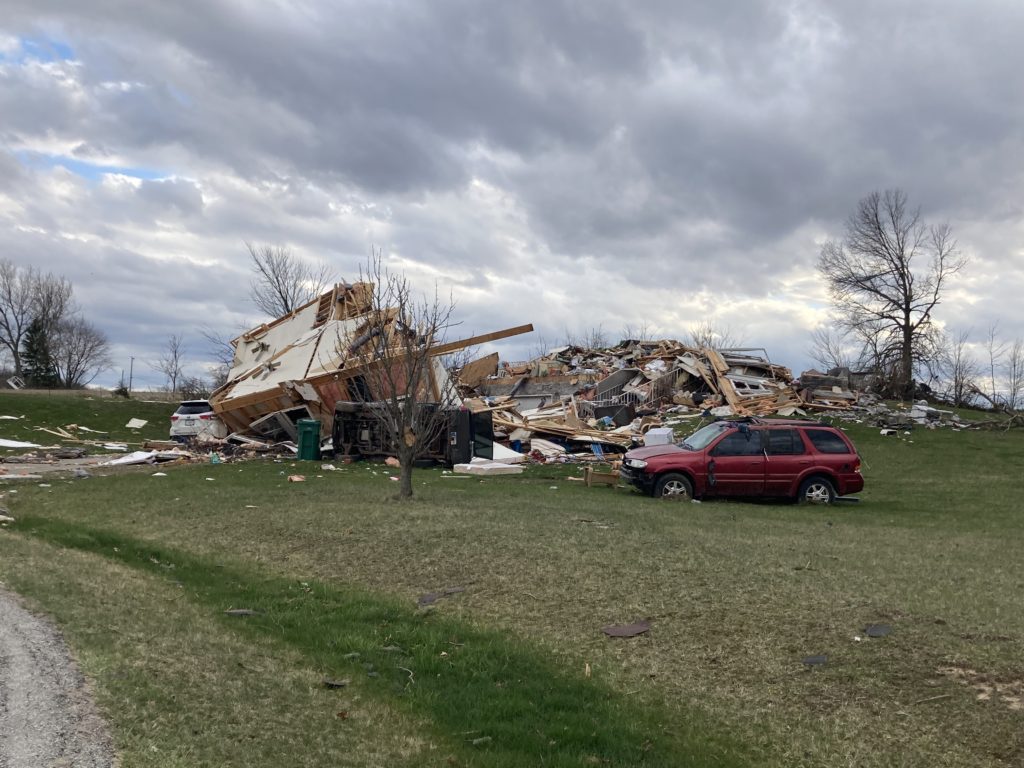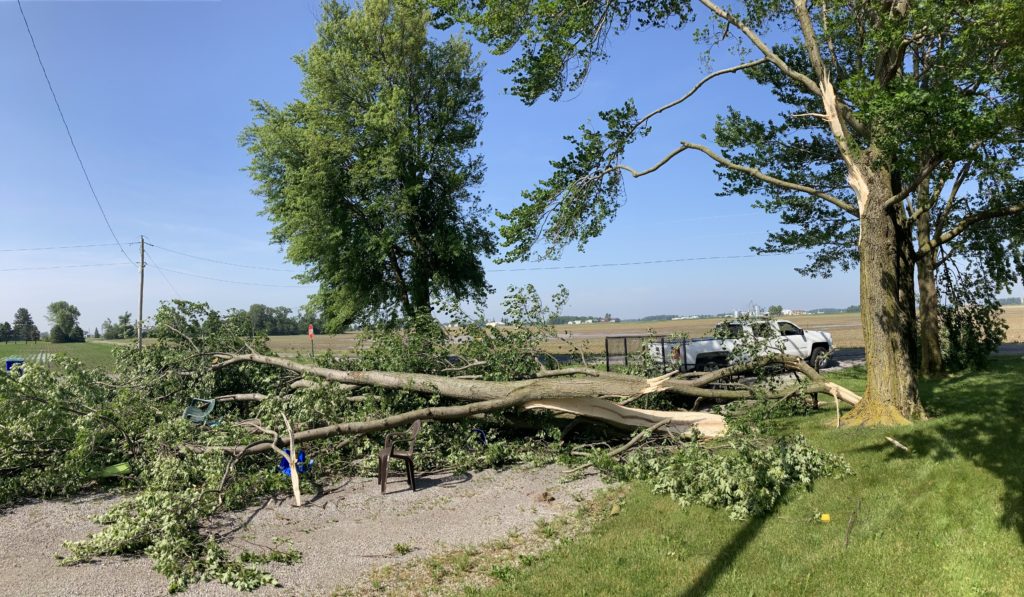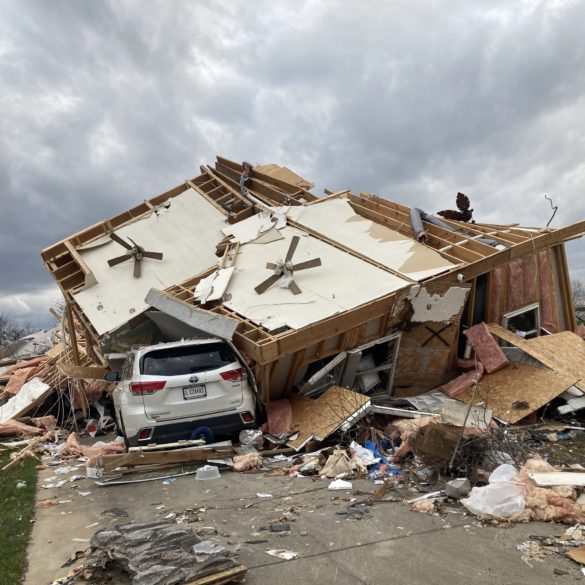Gas City’s turbulent twister
In March 2023, the Meteorology Club at Ball State University forecasted that a large-scale weather event was bound to cause devastation across the country later that month on March 31.
As a club consisting of several storm chasers, many celebrated the opportunity to chase powerful storms and tornadoes across Illinois and Indiana. Lance Huffman, a senior majoring in meteorology and the current president of the Meteorology Club, was one of these storm chasers.
Along with another friend from the club, Lance traveled to Illinois on that day and was able to witness a weak tornado and startling wind patterns.
“That day was very, very interesting because the storms were moving very fast,” Lance says. “They were moving almost as fast as 65 to 70 miles per hour.”
Lance and his friend returned to Indiana without incident, but he was shocked to see that a tornado caused destruction in Gas City, Indiana, that same night. More shocking still, he recounted that March 31 ended up being the third-largest tornado outbreak in United States history, according to the National Weather Service. Wanting to assess the amount of destruction for himself, Lance traveled to Gas City the next day to see the aftermath.
The National Institute for Occupational Safety and Health (NIOSH), a department in the Centers for Disease Control and Prevention (CDC), is an organization dedicated to protecting American workers, including during natural disasters. There are several types of disasters: hurricanes, tornadoes, earthquakes, tsunamis, floods, etc.
According to the NIOSH, natural disasters often have a high risk of impacting human health and safety. Because of this, these natural events require immediate attention and action. Natural disasters affect local infrastructure and impede progress on day-to-day activities for civilians and workers.
The storm’s aftermath
Leslie Montgomery, a disaster officer for the Indiana Red Cross, distinctly recalls the dozens of homes destroyed around southern Indianapolis by the same 2023 tornado outbreak that Lance witnessed. As a Red Cross representative, it was her job to assess the damage and needs of the civilians who were affected by the tornado.
“A whole area was just completely wiped out,” Montgomery says. “Going through that area and seeing the clients and talking to them about their experiences was very meaningful to me.”

She recounted how the Red Cross volunteer response teams all receive standardized training to handle disaster situations. In larger-scale natural events like storms and tornadoes, she emphasizes the importance of safety and following the rules at a disaster site. Just because people are in danger does not give a responder an excuse to put themselves in harm’s way. During tragic events, all lives and hazards need to be considered.
According to the NIOSH article, there are countless dangerous elements to be wary of in the direct aftermath of a natural disaster: debris, smoke, heat, anthrax, collapsing structures, fire, explosions, and more. Montgomery states that Red Cross response teams, on top of assisting clients with their needs, must be wary of how they engage with these environmental hazards.
Lance witnessed environmental hazards and destruction firsthand when he visited Gas City. He observed a home that had been turned upside down.
“One of the homeowners got trapped, and they had to get help,” Lance says. “They were all okay. The nice thing about this event is that there were no fatalities with that specific tornado.”
There was still a considerable amount of property damage for locals to deal with. For instance, the home Lance witnessed was affected to the point it was rendered entirely unlivable.
David Call, a professor of geography and meteorology at Ball State, studies hazardous weather, such as blizzards, hurricanes, and tornadoes. As part of his studies, he takes his meteorology students on field trips to other states to witness the long-lasting effects of violent storms. One of the cities they often visit is New Orleans, which is along the Gulf of Mexico.
“It takes five to 10 years for things to essentially be rebuilt,” Call says. “I’ve taken students to New Orleans, and you can still see scars from Hurricane Katrina, and that was 18 years ago.”
The time it takes to rebuild can vary based on the severity of the incident, and the same goes for emotional damage.
Emotional impacts
Lance had mixed emotions when it came to storm chasing and witnessing destruction. He expressed that meteorologists love chasing storms and feel an adrenaline rush as they race toward what fascinates them most. However, as much as they enjoy experiencing powerful weather phenomena, no one enjoys seeing the damage to life and property afterward.
After the adrenaline rush is over, Lance often feels an eerie peace. The sun comes back out, the birds start singing, and raindrops glisten in the light, casting off rainbows. But in the middle of it all, he cannot ignore the destruction.
Montgomery says anxiety can occur both before, during, and after a disaster has happened. Several of her clients continue to have trauma in 2024 from the spring tornado outbreak the previous year.
“We’ve seen that with different tornadoes and different storms where they have that kind of long-term trauma but also the long-term recovery of rebuilding their lives,” Montgomery says.
Two of the services the Red Cross disaster management team frequently offers to communities are community counseling and preparedness training to help calm their nerves and come together to support each other through hard times.

Preventative measures
Preparedness, Montgomery says, is one of the best ways to prevent disasters. Even if a natural event causes a lot of damage, with the proper amount of planning, it can go from being a devastating event to a manageable one.
According to NIOSH, comprehensive preventive plans help manage resources and protect responders.
Not only is it important to make a plan to manage disasters, but it is also important to identify which communities are most at risk.
According to Our World in Data, people who have low incomes are often the most vulnerable to disastrous events. Deaths can be prevented by improving living standards, infrastructure, and response systems in these regions.
It is not realistic to expect everyone to invest their time and money into supporting infrastructure and response systems. There are other smaller ways communities can prepare themselves for when the weather inevitably turns.
“For storms, tornadoes, or hurricanes, store extra water,” Call says. “For all disasters, make sure your cell phone and other devices are all well charged because you may lose power for an extended period.”
He suggests investing in a power generator or making a hotel reservation in advance of a storm. To prepare for potentially getting trapped inside a vehicle, Call says to store a survival kit in the car and have a portable radio on hand for weather updates.
If posed with the possible threat of a storm, Lance recommends a simple solution for everyone to dedicate time to: establishing an escape route. He says it’s crucial to have a readily accessible east-west escape route and a north-south route without traffic.
“There’s always an opportunity to get a new house or a new car, but we can’t rebuild you. We can’t rebuild a human,” Lance says.
Sources: National Weather Service, NIOSH, CDC, Our World in Data




